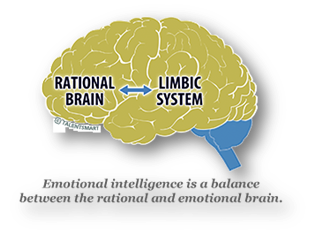Topic 2.3: Strengthening Emotional Intelligence and Mindfulness
The good news is that Emotional Intelligence and mindfulness can be enhanced and honed with practice and deliberate attention. Travis Bradberry offers some insights that may be useful in considering your own development plan.
 “The communication between your emotional and rational ‘brains’ is the physical source of emotional intelligence. The pathway for emotional intelligence starts in the brain, at the spinal cord. Your primary senses enter here and must travel to the front of your brain before you can think rationally about your experience. However, first they travel through the limbic system, the place where emotions are generated. So, we have an emotional reaction to events before our rational mind is able to engage. Emotional intelligence requires effective communication between the rational and emotional centres of the brain.”
“The communication between your emotional and rational ‘brains’ is the physical source of emotional intelligence. The pathway for emotional intelligence starts in the brain, at the spinal cord. Your primary senses enter here and must travel to the front of your brain before you can think rationally about your experience. However, first they travel through the limbic system, the place where emotions are generated. So, we have an emotional reaction to events before our rational mind is able to engage. Emotional intelligence requires effective communication between the rational and emotional centres of the brain.”
“’Plasticity’ is the term neurologists use to describe the brain’s ability to change. Your brain grows new connections as you learn new skills. The change is gradual, as your brain cells develop new connections to speed the efficiency of new skills acquired.”[1]
First, develop the habit of ‘self-awareness’ – noticing what is happening to you emotionally and physically in different situations, environments and conversations. Being able to consciously describe what is happening to you helps you regain self-control. So a first step in developing emotional intelligence is to note what happens to you when you find yourself in different situations that evoke emotional reactions.
Second, begin to think about your options for responding to the emotional effects you are experiencing. Often, the response that ‘takes over’ in emotionally difficult situations (conflict, uncertainty, danger, change) is a ‘fight, freeze or flight’ response. It’s hard to be any sort of intelligent when that happens! Being conscious of our reactions and of the fact that we have choices and options means that we can redirect mental and emotional energy towards those choices and options, rather than simply falling victim to primal panic and preservation responses.
Third, manage your physical state. Breathing steadily (rather than quickly and shallowly), relaxing your body (rather than allowing it to maintain a hyper-tense state), and controlling your physical movements (rather than rushing clumsily as often happens under pressure) will help you to manage your physical state.
Fourth, begin intentionally practising ‘self-management’ – consciously trying more controlled responses in previously reactive situations. For example, rather than retreating when an aggressive person approaches you or a group you are in, note your emotional reaction, control your breathing and think about a more assertive way of engaging them. It may take a few attempts before you achieve an actual verbal response, but that’s ok – you are managing yourself.
These strategies will help you as you deal with group diversity and conflict situations, enabling you to better harness your own and others’ creativity and perspectives.
The article by Dr Norman Rosenthal, MD, located on your deeper learning section, offers some additional insights into developing emotional intelligence.
Required Reflection
20 min
Make some journal notes about key ideas from the various readings from this module. Also, identify a couple of situations in which you demonstrate positive emotional responses and in which you notice responses you would like to improve and mange more effectively.
Deeper Learning Reading
10 min
- Bradberry, T. (2014) Emotional Intelligence – EQ. Forbes (Jan). Retrieved from: https://www.forbes.com/sites/travisbradberry/2014/01/09/emotional-intelligence/?sh=17b808b51ac0 ↵

